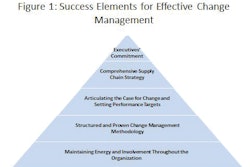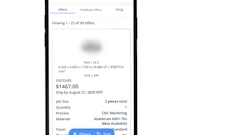Stryker Instruments designs and manufacturers a range of complex specialty surgical equipment used in operating rooms around the world. But when it comes to deploying new technology to streamline the company's supply chain, Stryker's operating philosophy is "keep it simple," according to Mark Lincoln, director of manufacturing at the Kalamazoo, Mich.-based division of $4.87 billion Stryker Corporation.
"Many of our strategies are built around simple philosophies, and the simplest is, let's not make things more complicated than they need to be," says Lincoln, who recently had the opportunity to put that philosophy to the test when Stryker undertook a project to improve inventory visibility and real-time communications with its supply base. Lincoln's experience leading this supply chain enablement project offers insights into the benefits and challenges of applying simplicity to complex supply chain problems.
The Groundwork for Transformation
Stryker Instruments first developed a strategy for improving its supply chain back in the mid-1990s, when the company also began working externally to establish closer partnerships with its suppliers. At the time, Stryker's approach was to share as much information as possible with its supply base, albeit in a manual fashion, to help the suppliers run their own businesses more efficiently and, consequently, serve Stryker better. The company also established a supplier advisory board that met quarterly with Stryker's top dozen suppliers to discuss issues in the supply chain and ways to improve the supply chain that would benefit all the parties involved.
In the late 1990s and moving into the new millennium, Stryker turned its focus to its own operations, working internally to implement lean manufacturing and streamline its production processes. As those efforts progressed, the company began to look at addressing two supply chain issues. First, Stryker wanted to target inventory reduction by implementing an electronically enabled, or e-commerce-based, vendor-managed inventory (VMI) program. "I wouldn't say that inventory management was a huge problem for use, but we just knew that we wanted to do something different to control our inventory a little bit better," Lincoln says. Essentially, Stryker wanted to give its U.S. and overseas suppliers visibility into the division's inventory information without having to implement an expensive electronic data interchange (EDI) system. Data targeted for exchange with suppliers included forecast, consumption, shipping and receipt information coming from the company's manufacturing resource planning system at its Kalamazoo facilities.
In addition, the company thought that it could streamline its purchasing function so that Stryker could maintain or reduce headcount in procurement even as it grew the business. The company also believed that if it could relieve its procurement staff of manual chores and day-to-day management tasks, the purchasing function could refocus on more strategic activities and become more proactive in managing the company's supply chain.
As Stryker began examining its options for accomplishing these two goals, the company turned to its supply base for consultations — and this is where all the relationship- building that Stryker had done in years past paid off. Rather than encountering a suspicious supply base wary of change, Stryker found suppliers amenable to participating in the project. "We created a steering committee with our suppliers and tried to make sure we were able to answer all the questions and concerns that they would have from a supply chain standpoint. We didn't do [this project] in a vacuum," Lincoln explains. Together, Stryker and its suppliers drew up a set of functional specifications that included the top ten capabilities they believed were necessary in a solution to address Stryker's two objectives. This process ensured supplier buy- in for the project from the very start and would help smooth the implementation of the solution later.
The Simple Approach
Lincoln says that Stryker's approach in searching for a solution to meet its requirements was to look for a tool that would address the specific objectives the company had in mind, enabling inventory visibility and real-time communications with suppliers to establish a workable VMI process. "We didn't want to revamp everything that we were doing, we just needed to get better and quicker at communicating," Lincoln explains.
After reviewing its options with its suppliers, all parties agreed that the best choice was a solution called i-Supply from TradeBeam, a San Mateo, Calif.-based software company offering a suite of supply chain applications that address the end-to-end procure-to-pay cycle, including inventory management. Simplicity was a key selling point for the TradeBeam solution, according to Lincoln. "It was very intuitive to use, and it just made sense," he says. "It wasn't a big ERP project. There wasn't going to be a half-year or year- long implementation, and it met our particular needs in terms of inventory visibility and real-time communication."
The TradeBeam solution provides the company's suppliers with real-time inventory consumption, forecast and shipping data, as well as visibility into their supply chain interactions with Stryker. Suppliers can use a Web browser to communicate advanced shipping notices (ASNs) and promise-to-ship information to Stryker as well. And TradeBeam's solution provides alerts to supply chain participants, allowing for more proactive, exception-based management of the supply chain.
Rolling out the New Process
Stryker signed the contract with TradeBeam in the fourth quarter of 2000, went through system setup and training for in-house staff and suppliers by the end of the year, and went live in January 2001 with a pilot program that lasted through April of that year. As the company rolled the solution out to its broader supply base during the pilot, Lincoln and his team went site to site around the supply chain to introduce vendors to the new process, spending a half-day or day with each supplier to ensure that they were onboard with the solution.
A few suppliers did express some initial concern that implementing TradeBeam might actually make their job harder because the system called for exchanging much more information with Stryker. "But," Lincoln says, "once we got them fully trained and they really understood it, they absolutely embraced it and didn't want to get rid of it." Stryker did wind up taking a couple suppliers off the system temporarily because they were unable to assimilate the new solution into their processes and learn the solution's functionality at the initial pace that Stryker had set. However, additional training ameliorated these difficulties, and Stryker eventually brought those suppliers back into the system.
Here again, the good relations that Stryker had built with its suppliers were an asset that the company was able to tap into as it drove the rapid, widespread adoption of the solution. "If we hadn't had that relationship and instead just tried to force them to use a new program, I don't think we would have been as successful implementing this with our suppliers," Lincoln says.
Internally, the only issue that arose within Stryker stemmed from the rapid implementation pace that the company has set for the project. The foreshortened timetable got the solution up and running quite quickly, but subsequent to the go-live Stryker went back and made various modifications to the system, which meant additional work for the company's information technology staff and TradeBeam's project staff. "We might have spent a little bit longer in the set-up phase trying to think of all the different scenarios and ways that we could use this tool, and all the information we wanted to pull from our ERP system into TradeBeam," Lincoln admits. "But the flipside of that is that every day we might have spent trying make it perfect before we implemented it would have been costing us money. There's a fine line between spending all the time out front and getting it perfect versus implementing it and fixing it later but getting the benefit of it right away."
Measuring the Impact
To date, Stryker has rolled out the new process and the TradeBeam solution to close to 100 suppliers, accounting for more than 95 percent of its direct materials spend. Stryker actually uses the solution to track 100 percent of its parts because of the visibility that the system provides to the company's buyers, but the suppliers of about 5 percent of the parts that the company buys are not using the system to manage their business with Stryker.
The manufacturer did not have a specific inventory reduction goal in mind going into the project, according to Lincoln. "As we were selling this expense and this new project across our organization, we wanted to be careful not to lay out the whole ROI in terms of reducing inventory by X dollars," he says. "Because we didn't know at the time — maybe this new system would say that we needed more inventory in certain areas. Six months later, if we hadn't reduced inventory but we were running a better business, we didn't want that to be considered bad."
Nevertheless, Stryker has documented inventory reductions of 30 percent over time, as well as an increase of 16 percent in inventory turns, and the elimination of expedited freight and stock-out occurrences. In fact, Lincoln says that the company recorded double-digit inventory reductions within the first 90 days, achieving a full payback on the division's investment in the solution before the pilot project was even completed. In addition, the company was able to reduce its materials staff by two people since going live, even as Stryker's purchases grew by double-digit percentages in the three years following the implementation.
As important, the division has continued to increase its service levels to its end customers. Lincoln says that the TradeBeam solution cannot fully take credit for that result, but it has played a significant role in streamlining order processes between Stryker and its distribution centers internationally, with previously manual processes now handled using EDI through the system. And the system has helped Stryker's own suppliers improve their performance as measured, for example, by such metrics as "short parts" versus "green parts." "It hasn't eliminated stock outs and back order situations, but it has allowed us to identify those situations more quickly and focus on those exceptions a lot quicker than our old system," Lincoln says.
Looking back on the project, Lincoln believes that a key lesson to take away from the project is the importance of solid, long-term relations with the supply base when a company is attempting to quickly transform its supply chain. In Stryker's case, the collaborative relationship that the division had built with its suppliers allowed the different parties to work together to identify a suitable solution that met a shared set of requirements and that would benefit all sides. In this instance, that was important not just for the suppliers but for Stryker as well. "Because you're at the mercy of the supplier," Lincoln says, "It's true vendor managed inventory, so if you don't have the trust in them and they don't have the trust in you, you're setting yourself up for failure."
Sidebar: Best Practices
Build relationships early — Establish collaborative relations with suppliers before undertaking supply chain transformation.
Keep it simple — Don't try to solve all your problems at once.
Don't paint yourself into an ROI corner — Define your return on investment carefully so that overall positive results are not overshadowed by shortfalls on isolated metrics.
Sidebar: ROI
Inventory...........................................30 percent reduction
Inventory turns....................................16 percent increase
Expedited freight............................100 percent reduction
Stock-out occurrences...................100 percent reduction
Time to payback..............................Within first 90 days









![Pros To Know 2026 [color]](https://img.sdcexec.com/mindful/acbm/workspaces/default/uploads/2025/08/prostoknow-2026-color.mduFvhpgMk.png?ar=16%3A9&auto=format%2Ccompress&bg=fff&fill-color=fff&fit=fill&h=135&q=70&w=240)








